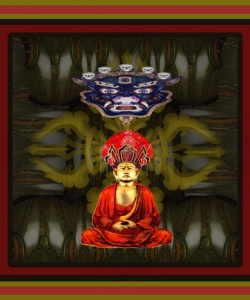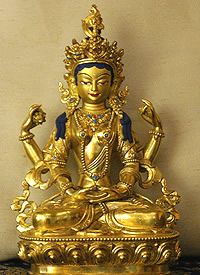The Foundational Standpoint of Mādhyamika Philosophy & Mādhyamaka Schools in India
The Foundational Standpoint of Mādhyamika Philosophy
By Gadjin Nagao. Translated with preface by John P. Keenan Mādhyamaka Schools in India: A Study of the Mādhyamaka Philosophy and of the Division of the System into the Prāsaṅgika and Svātantrika Schools
By Peter Della Santina. Foreword by Lai Mani Joshi Reviewed by David Loy Philosophy East & West Vol. 42, No. 1 (1992) pp. 187-190 University of Hawaii Press Hawaii, USA
p. 187 The Foundational Standpoint of Mādhyamika Philosophy & Mādhyamaka Schools in India Philosophy East and West, Vol. 42 (1992)
Professor Nagao's book is an attempt to understand Mādhyamika along the lines of Tsong-kha-pa's Steps on the Way to Enlightenment (Lam-rim chen-mo), a text that Nagao (now emeritus professor of Buddhist studies at the University of Kyoto) first studied during visits to Lamaist monasteries in Mongolia.
This reading is contrasted with the more familiar one (at least in East Asia) of Chi-tsang's San-Lun school, whose overemphasis on emptiness falls into a dogmatism that devalues dependent co-arising and hence the conventional world.
Two main themes are interwoven. First, the fundamental standpoint of Mādhyamika is that emptiness (śūnyatā) is identical with dependent co-arising (pratītya-samutpāda). It is important not to elevate one over the other, for then one ends up with either a purely negative logic of emptiness or a merely organismic view of dependent-arising being.
This also relates to Nagao's lifelong concern to understand the relationship between Mādhyamika and Yogācāra as not adversarial but complementary; identifying emptiness with dependent co-arising makes other-dependence (paratantra in Yogācāra) the key term for both, the gab between delusion and liberation.
"[T]he other-dependent pattern entails the path and plays a mediating role among the three patterns as the skillful method for entering the unmarked" (p. 82). This seems to me not only right but essential, although the point goes beyond the importance of cause-effect relationships for any spiritual path: for both schools, other-dependence is the intermediate stage that dissolves our essentialist commitments and, by then refuting itself (if there are no things, there are no others), opens up the possibility of tathatā, "thusness."
The other main theme is the absolute disjunction between the two
p. 188 The Foundational Standpoint of Mādhyamika Philosophy & Mādhyamaka Schools in India Philosophy East and West, Vol. 42 (1992)
truths. "The only true and absolute dichotomous contradiction, which can never be resolved, is between worldly convention and ultimate meaning" -- a claim soon contradicted: "The actual world is not two but one, and therefore the two truth realms cannot be made so completely other as to refer to separate worlds of meaning." Final absolute meaning is "completely other," beyond cause and effect, ineffable and silent, yet on the other side, "the ordinary realm of worldly convention itself comprises the entire content of ultimate meaning (pp. 26, 97, 102, 110).
The book becomes a series of reflections, usually erudite and often insightful, on both of these claims. Nagao's reason for describing the two truths as unrelated is to avoid overemphasizing either: if we don't distinguish them they tend to fuse into one, and we either end up prisoners of the conventional, as the only truth we know, or suppose ultimate meaning to govern worldly conventions.
The opposite danger of dissociating them completely is to end up detesting all worldly and conventional activity (pp. 100-102). Then isn't the challenge to understand the difference-in-identity or identity-in-difference of the two perspectives? Whatever the limitations of thought, it becomes the task of Buddhist philosophy to illuminate this relation as much as possible.
Although Nagao elaborates both, I can't see that these two apparently inconsistent claims are ever reconciled. However, the prose is so dense and difficult that another factor may be interfering with his argument: the quality of the translation. The reason I can only suspect this is that nowhere in the text could I find the title of the Japanese original from which this book is translated, and my efforts to discover it in Japan have also been unsuccessful.
One of the main attempts to clarify things introduces an element that is not part of the foundational standpoint of Mādhyamika. Nagao refers to another kind of "other-awareness:" the dependent co-arising manifestation of truth "comes from beyond;" it is a turning toward as of an other-power (pp. 48, 59). This Pure Land notion may be somewhere in Tsong-kha-pa, but it may also originate in Nagao's own Joodo Shinshū background; in either case, there's no reference to this sort of "other dependence" in the Mūlamadhyamikakārikā.
Any appeal to an other power is inconsistent with the main thrust of Nāgārjuna, who works to deconstruct all dualisms such as that between other-power and self-power, and to deny what Nagao asserts, that "the light [of discernment) must be introduced from elsewhere" (p. 47).
This also applies to Nagao's concept of two-dimensional activity, the ascent to transcendence ("the divine realm") and the descent to worldly reengagement ("the human realm"), both of which he judges necessary for authentic religious teaching. Again, these dualistic metaphors are not Nāgārjuna's and I think we remain more true to his perspective if we look at them critically, asking how much they help us and how much they hinder. That ties in with our tendency today to ask: what might these meta-
p. 189 The Foundational Standpoint of Mādhyamika Philosophy & Mādhyamaka Schools in India
Philosophy East and West, Vol. 42 (1992)
physical claims mean phenomenologically? Nagao touches on the important point when he quotes the Diamond-Cutter sūtra that "this understanding arises when one has no abiding point when he quotes the Diamond-Cutter Sūtra that "this understanding arises when one has no abiding point."
Emptiness cannot be "grasped" without experiencing the freedom of nonattachment, exemplified in the nonabiding cessation (apratiṣṭhita-nirvāṇa) of the bodhisattva. It is clear in the other prajñāpāramitā sūtras (as long as we are not in quest of somewhere to abide) that this is what liberates: "No wisdom can we get hold of, no highest perfection, no Bodhisattva, no thought of enlightenment either...
In form, in feeling, will, perception and awareness, nowhere in them they find a place to rest on. Without a home they wander, dharmas never hold them, nor do they grasp at them..." (The Perfection of Wisdom in Eight Thousand Lines and its Verse Summary, trans. Edward Conze (Bolinas, California: Four Seasons Foundation, 1973), 1:5-6, pp. 9-10).
This is not a process of ascent to some divine realm followed by return to the human realm, but a transformation in the way we experience this world: "To the extent that beings take hold of things and settle down in them, to that extent there is defilement. But no one is thereby defiled. And to the extent that one does not take hold of things and does not settle down in them, to that extent can one conceive of the absence of I-making and mine-making.
In that sense can one form the concept of the purification of beings, i.e., to the extent that they do not take hold of things and do not settle down in them, to that extent there is purification. But no one is therein purified " (ibid., no. 400, pp. 237-238).
When this is applied to the concept of truth, it becomes a self-reflexive critique that kicks the ladder out from beneath itself as well as all other attempts to grasp the truth -- including the two-truths doctrine -- which is why the foundational standpoint of Mādhyamika is that no foundation is to be found in anything, anywhere.
That is how Mādhyamika can be, as Nagao concludes, "a standpoint that is not a standpoint; it comes into play only in regard to 'that which is admitted by the other.'" (p. 141)
Nagao ends by observing that Mādhyamika reasoning, which he little discusses, can be studied only in connection with the split between the Svātantrika and Prāsaṅgika schools. Mādhyamaka Schools in India does just that. It develops an interpretation of their debate first suggested by bSod-nams Sen-ge, a fifteen-century Tibetan scholar, in The General Meaning of Mādhyamaka (dBu-ma spyi-ston).
The usual understanding of that disagreement (as in Tsong-kha-pa) locates the divergence in different attitudes toward language: the Svātantrika spokesman Bhāvaviveka affirms that essences exist in language, while the Prāsaṅgika defender Candrakīrti denies even those essences. bSod-nams Sen-ge saw the principal issue as more subtle, being pedagogical as well as epistemological. Della Santina puts this in context by describing the formalization of Indian logic after Nāgārjuna, which was an inevitable response to the
p. 190 The Foundational Standpoint of Mādhyamika Philosophy & Mādhyamaka Schools in India
Philosophy East and West, Vol. 42 (1992)
evolving tradition of public debate. Bhāvaviveka's independent syllogism (svatantra-anumāna) is "an obvious compromise on the part of a Mādhyamika scholar with the increased formalization of Indian logic, "but this tendency also affected the Prāsaṅgikas, including Candrakīrti (p. 55). They disagreed over what is conventionally real (vyavahāra).
Prāsaṅgika denies such validity even to common processes of cognition (they presuppose duality), which meant they had to rely solely on reductio ad absurdum arguments; the Svātantrikas (epistemological realists) believed it was necessary to agree to the conventional existence of a common substance in order for arguments to result in valid inferences logically compelling to one's opponent.
In explaining the issues involved, Della Santina discusses in detail Nāgārjuna's Vigraha-vyāvartani, which refutes all supposedly valid forms of cognition. One argument is just as effective against all "foundationalism" in philosophy: "If it is held that all entities must necessarily be established through the valid instruments of cognition themselves are established or proved" (stanza 31). There is no escape from infinite regress.
In discussing the first stanza of the Mūlamadhyamikakārikā, Della Santina reviews all of Nāgārjuna's arguments against origination and then devotes a chapter to her refutation of each of the four alternatives, refutations which are just as important today because they not only refer to Indian theories of Nāgārjuna's time but reflect the dialectical nature of reason: our tendencies to perceive (respectively) identity, permanence, and substance; difference, impermanence, and modes; syncretism; and skepticism or nihilism.
The debate over the acceptability of the independent syllogism finally came down to the nature of the logical subject (substratum). The syllogism's validity was questionable because it employed mutually opposed orders of reality: it was agreed that the predicates (which negated origination) belong to the level of ultimate reality, while the subjects and reasoning belong to the level of empirical reality.
Their incompatibility meant such arguments could not be valid. Della Santina concludes that the Prāsaṅgikas won logically as well as historically: they were more consistent with Nāgārjuna himself and more sophisticated -- but that sophistication was largely a product of the debate.
The Prāsaṅgika/Svātantrika debate makes me wonder what is really at stake in all such quests to discern what is really (as opposed to conventionally) real. When we decide that something is real or unreal, as part of our search for being, what difference does that make to our lives? If our intellectual search is a sublimated attempt to ground ourselves by "grasping the concepts that grasp reality," we have yet to feel the force of the Mādhyamika critique of philosophy.





